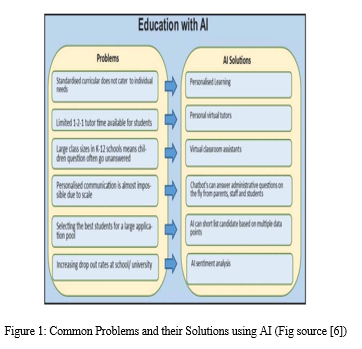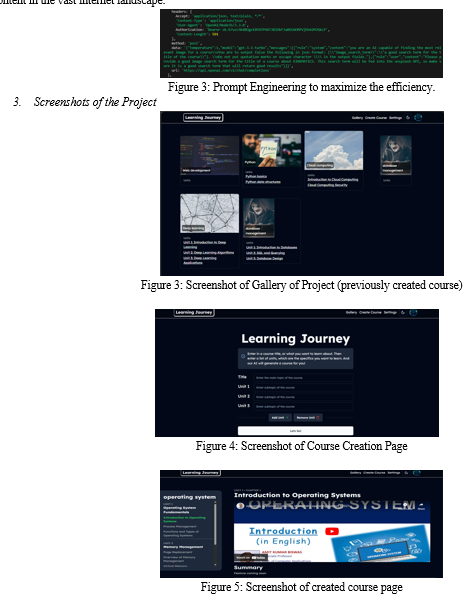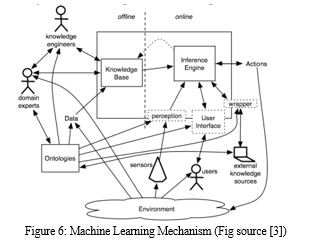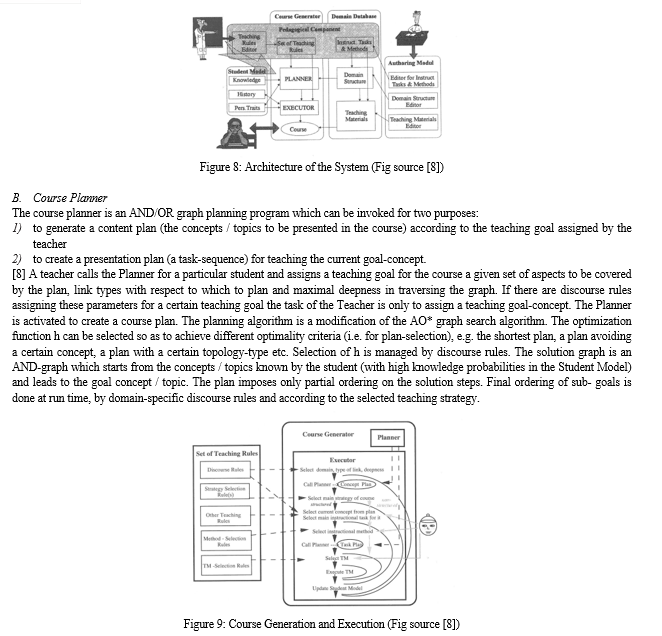Ijraset Journal For Research in Applied Science and Engineering Technology
- Home / Ijraset
- On This Page
- Abstract
- Introduction
- References
- Copyright
Application of AI in the Field of Education: Dynamic Course Generation
Authors: Pranav Singh Sehgal, Nausheen Noor Zaidi , Dr. Sadhana Rana
DOI Link: https://doi.org/10.22214/ijraset.2024.61320
Certificate: View Certificate
Abstract
This research article examines the evolving relationship between Artificial Intelligence (AI) and Education, exploring its impact and potential. It covers adaptive learning systems, intelligent tutoring platforms, and emerging technologies, analyzing real-world applications and addressing ethical and implementation challenges. By synthesizing research findings, it contributes to understanding AI\'s role in transforming learning paradigms.
Introduction
I. INTRODUCTION
In the rapidly evolving landscape of education, the integration of Artificial Intelligence (AI) has emerged as a transformative force, reshaping traditional paradigms and ushering in an era of unprecedented possibilities. As we stand at the intersection of technology and pedagogy, this research paper delves into the dynamic advancements of AI in education, exploring how intelligent systems are revolutionizing teaching and learning experiences. From adaptive learning platforms that tailor instruction to the unique needs of individual learners to intelligent tutoring systems that provide personalized guidance, the synergy between AI and education is opening new horizons. With a focus on innovative applications, emerging technologies, and their implications, this paper aims to provide a comprehensive overview of the current state and future prospects of AI in education. As we navigate this transformative journey, understanding the intricate interplay between AI and education becomes paramount for educators, researchers, and policymakers alike. Join us in unravelling the potential of AI to shape the future of learning, paving the way for a more personalized, inclusive, and effective educational landscape.

II. PROBLEM STATEMENT
In the information age, YouTube serves as a vast repository of educational content, and people often face a big challenge: there is no system and standard way to watch video lectures. Lack of attention to learning can cause users to feel nervous while watching too many videos, which can hinder self-learning. In addition, teachers and students often need specific video materials for further studies, research projects or classroom instruction. There is a huge gap in digital education where there are no tools to optimize and organize these resources according to the user's content.
So the current problem is the lack of reliable and user-friendly tools. This solution uses web scraping technology to download, distribute and save quality educational videos on YouTube. The tool should provide a great learning experience by allowing users to access the topics they want and create a video tutorial playlist that meets those needs.
Solving this problem is essential to liberating education and empowering people, transforming the way we approach digital education by providing effective engagement and easy access to exclusive video topics.
III. PROPOSED METHODOLOGY : LEARNING JOURNEY (A PROTOTYPE)
- Overview: Learning Journey is a prototype of the prospective solution regarding the above problem statement. It is a web-based software which enables user to generate a structured course by just specifying the related topics.
It is a light-weight and highly affordable web application which uses a pre-trained AI model (GPT model in this case) to recommend the videos related to the topics and list them according to user’s preferences.
The courses made by users are stored in a local database for improving the search results and for caching purposes. This simple model enables us to explore the possibility of innovation in the field of education with the help of AI.

2. ChatGPT introduction
ChatGPT is an advanced language model developed by OpenAI, based on the GPT-4 architecture. It has been trained on a large corpus of text and has the ability to generate human-like responses in various contexts. ChatGPT’s primary strength lies in its ability to understand and generate text in a wide range of domains, making it suitable for applications such as customer support, content generation, and interactive storytelling
ChatGPT is an advanced language model developed by OpenAI, based on the GPT-4 architecture. It has been trained on a large corpus of text and has the ability to generate human-like responses in various contexts. ChatGPT’s primary strength lies in its ability to understand and generate text in a wide range of domains, making it suitable for applications such as customer support, content generation, and interactive storytelling
ChatGPT is an advanced language model developed by OpenAI, based on the GPT-4 architecture. It has been trained on a large corpus of text and has the ability to generate human-like responses in various contexts. ChatGPT primary strength lies in its ability to understand and generate text in a wide range of domains, making it suitable for applications such as customer support, content generation, and interactive storytelling.
Prompt engineering enables the app to tailor content delivery, encourage active participation, and enhance user engagement. The project harnesses the power of prompt engineering to optimize the user experience and achieve its goals of nurturing structured content in the vast internet landscape.

IV. SOME SUBSIDARY TECHNIQUES
A. Adaptive Learning
Artificial assumes a pivotal role in shaping adaptive learning systems, leveraging advanced technology and capabilities. Machine learning algorithms serve to scrutinize extensive datasets encompassing learner profiles, performance metrics, and educational resources. By discerning patterns, trends, and correlations within the data, AI algorithms intelligently forecast learner needs, preferences, and future performance. This, in turn, empowers adaptive learning systems to dynamically tailor content, pacing, and instructional approaches according to the distinct requirements of individual learners, fostering a personalized and efficient learning journey.
AI-driven adaptive learning systems comprise multiple interconnected components synergistically working together to deliver a personalized educational encounter. Learner modelling entails the creation and upkeep of individual learner profiles, encompassing data such as assessment scores, learning preferences, progress tracking, and even socio-emotional factors. Content customization relies on AI algorithms to adapt the complexity, format, sequence, and delivery of learning materials dynamically, guided by learner profiles and real-time feedback.
Feedback mechanisms integrated into adaptive learning systems furnish timely and individualized feedback to learners, enabling them to monitor progress, pinpoint improvement opportunities, and make necessary adjustments to enhance learning strategies. Addressing challenges in platforms like OpenStax and ASSISSTments, well-known OER platforms necessitate instructors to verify their identity before accessing materials (Heffernan & Heffernan, 2014). This AI-fuelled feedback loop establishes a continuous cycle of assessment, refinement, and feedback, contributing to the ongoing enhancement of the effectiveness and personalization of the learning experience.
B. Natural Language Processing(NLP)
Natural Language Processing (NLP) is a tract of Artificial Intelligence and Linguistics, devoted to make computers understand the statements or words written in human languages. Natural language processing came into existence to ease the user’s work and to satisfy the wish to communicate with the computer in natural language.
There are variety of uses of NLP in today’s era like summarization, information extraction, Question-Answers, etc. These applications are further consumed in the educational field to give a more immersing learning experience to users. Some of the applications are discussed here:
- Machine Translation: Machine Translation is generally translating phrases from one language to another with the help of a statistical engine like Google Translate. The challenge with machine translation technologies is not directly translating words but keeping the meaning of sentences intact along with grammar and tenses. In recent years, various methods have been proposed to automatically evaluate machine translation quality by comparing hypothesis translations with reference translations. After gaining some level of accuracy in this technology, it can be integrated in various educational facilities to provide a more understandable and comprehensible subject knowledge to the users.
- Text Categorization: Categorization systems inputs a large flow of data like official documents, military casualty reports, market data, newswires etc. and assign them to predefined categories or indices. Another application of text categorization is email spam filters. Spam filters is becoming important as the first line of defense against the unwanted emails. This can also be incorporated by EdTech firms to segregate bulk educational content and provide user with the best library and interface for educating himself/herself.
- Information Extraction: Information extraction is concerned with identifying phrases of interest of textual data. For many applications, extracting entities such as names, places, events, dates, times and prices is a powerful way of summarize the information relevant to a user’s needs. There is use of hidden Markov models (HMMs) to extract the relevant fields of research papers. These extracted text segments are used to allow searched over specific fields and to provide effective presentation of search results and to match references to papers.
C. Machine Learning
Machine Learning is a crucial component of artificial intelligence, designed to enable machines to access data efficiently, easing human tasks and facilitating autonomous learning. Learning, as a fundamental aspect of artificial intelligence , refers to machines' capacity to assimilate real-time data and feedback, progressively enhancing their performance. This process involves the implementation of self-learning algorithms aimed at extracting knowledge from data to make accurate predictions. Machine learning serves as a key technical approach to AI, forming the foundation for numerous recent advancements and practical applications. In its contemporary form, modern machine learning is a statistical process integral to shaping output and guiding the future utilization of data.
D. Types of Machine Learning Models
A Machine Learning model can be trained in 3 ways:
- Supervised Learning: In this process, if the researcher tells the machine what the correct answer is for a particular input. It is most common technique for training neutral networks. It is solved by decision tress, naive tress, boosting and multi-layer neutral networks.
- Unsupervised/predictive learning: In this method, no labels are given to learning algorithm, leaving it on its own to find a structure in its input. It can be a goal in itself, i.e. hidden pattern and data. Researchers don’t know how to do at this moment, research is still going on. It is solved by grouping into K groups. Unsupervised learning is mostly applied on transactional data.
- Reinforcement Learning: In this algorithm, The AI, Agent decides how to behave in order to get most of the work is done. A computer interacts with dynamic environment in which is must perform a certain task to win against opponent. The program gives feedback in terms of punishment or reward.

E. Application of Machine Learning
Tools enabled by Machine Learning play a crucial role in evaluating an individual's current comprehension level, pinpointing gaps in a student's learning, and offering real-time solutions. Additionally, this technology can identify instances where the number of students surpasses available teachers, leading to the creation of optimized learning programs that benefit a larger student population. The following highlights some advantages of Machine Learning, showcasing its transformative impact on education:
- Predicting Student Performance: Machine Learning excels in predicting student performance by comprehensively "learning" about each student. This enables the technology to discern weaknesses and recommend tailored learning tools, such as additional practice tests, for individual students
- Fair Student Grading: Machine Learning contributes to fair student grading by eliminating human biases. While AI is already employed for grading multiple-choice exams, we are witnessing the emergence of machine learning assessing writing through tools like Grammarly.
- Effective Content Organization: By identifying weaknesses, Machine Learning enhances the organization of educational content. For instance, as students master one skill, they seamlessly progress to the next, continuously building upon their knowledge.
- Suggested Learning Paths: Following a thorough analysis of students' performance, the software may suggest improved approaches to learning new material. This process initiates with an examination of the existing curriculum knowledge, and upon identifying weak spots, students receive recommendations for materials and alternative learning methodologies.
F. Computer Vision
Computer Vision (CV) is an interdisciplinary field which deals with understanding digital images or videos, as well or even better than humans do. The main tasks of CV are acquiring, processing, analyzing, and understanding the environment through digital images.
Some high-level problems which are successfully tackled by CV are optical character recognition (OCR), machine vision inspection, 3D model building (photogrammetry), medical imaging, automotive safety, motion capture, surveillance, fingerprint recognition, face recognition, and gesture recognition.
In the past years, CV has touched upon all fields of modern life, including teaching and education. One of the common ways in which CV is involved in this field is through Augmented and Virtual Reality technologies
V. DYNAMIC COURSE GENERATOR
[7] There are quite a limited number of publications and software products that reflect the use of content generators in the field of electronic education
[7] Manual preparation of multivariate tasks is difficult in the first place because of the amount of necessary monotonous work and the errors and misprints that arise. Many instructors independently from each other came up with ways to automate this process and wrote programs to generate options for the tasks they needed. Most generators created by instructors are used only by them, nevertheless from time to time they can share generators or multivariate tasks created with their help with their colleagues.
Instructors often use generator to prepare course materials and assignments which can be completed by students for course completion and to evaluate the understandability of the student about a particular topic. Creating generators is a complex work and in general, requires programming and implementing algorithms


VI. OPPORTUNITIES
A. Reducing Teachers' Workload:
AI presents a valuable opportunity to address the increasing workload faced by teachers. By automating administrative tasks like proofreading and course material composition, AI can significantly reduce the burden on educators.
B. Personalized Learning:
AI offers the potential for personalized learning, accommodating individual student needs that teachers might find challenging to address. This allows students to progress at their own pace, while teachers can focus on providing additional support.
C. Data-Driven Insights (Learning Analytics):
AI-driven learning analytics empower teachers with comprehensive insights into student performance. By exposing and mitigating cognitive biases, AI contributes to a fairer educational environment in terms of factors like ethnicity and gender.
D. Improved Assessment Practices:
In assessment, AI enables a shift from periodic tests to continuous monitoring of student knowledge. This move away from standardized tests provides a more accurate representation of a student's understanding.
E. Integration with Digital Learning Applications:
AI enhances existing digital learning resources by learning and adapting rules. When combined with technologies like Virtual Reality (VR), Augmented Reality (AR), and serious games, AI optimizes learning outcomes. However, caution is needed to ensure knowledge gained in virtual environments aligns with real-world applicability, maintaining the importance of less formalized knowledge acquired in traditional school settings.
VII. THREATS
A. Impact on Educational Objectives:
The overemphasis on technology in AI development poses a risk to educational objectives. When AI is narrowly focused on data and technology, there's a potential misalignment with educational goals. This could result in optimized AI for knowledge transfer lacking essential elements like motivation, and the entry of foreign actors into the education market may lead to a loss of control over educational processes.
B. Risks in Full Automation of Education:
Full automation of education, particularly when students undergo the educational process without human intervention, raises concerns about the humane nature of the learning experience. Excessive use of simulations for teaching adds another layer of risk, as knowledge and skills acquired in simulations may not be applicable in real-world scenarios.
C. Bias in AI from Human Data:
Deploying AI introduces a significant risk related to biases in human data being incorporated into AI systems. Historical data may contain biases against ethnicity and gender, potentially leading to a feedback loop that systematically disadvantages certain minorities.
D. Impact on the Teacher Labor Market:
There's a potential shift in the skills required for teachers due to the integration of AI. Data-driven education is not currently part of teacher training, and if teachers cannot adapt, there's a risk that future educators may lean towards becoming data scientists with a less robust educational background. However, the complete automation of teachers is considered highly unlikely in the near future.
E. Dependency on Incomprehensible AI Systems:
There's a risk of education becoming overly dependent on AI systems that lack transparency and understanding. Both teachers and AI systems need increased explain- ability and knowledge to navigate this risk. Teachers cannot be held responsible for systems they find incomprehensible.
F. . Implementing AI Without Prerequisites:
Before successful AI implementation in education, several prerequisites must be met, including a technical infrastructure and data availability. Rapid implementation without meeting these conditions may lead to unmet expectations, disappointment, and potential aversion to AI in education.
G. Concerns about Consolidation of Power:
The introduction of AI raises concerns about the consolidation of power with a single entity, such as an educational resource publisher or a tech giant. Recent developments suggest manageable risks, but policymakers remain cautious, acknowledging potential challenges related to data ownership and control.
VIII. POLICY RECOMMENDATION
It is evident that the integration of AI in the field of education holds significant potential across various domains. The education sector seems to welcome, if not enthusiastically embrace, the application of AI, particularly for automating administrative and specific educational tasks, such as test review and curriculum personalization. However, for AI to have a high impact, addressing fundamental legal and ethical questions is imperative.
The role of teachers in the context of AI implementation is a subject of ongoing discussion. While AI can support teachers and enhance the quality of education, educators are also expected to assume responsibility for decisions made by AI, handle data, assess the value of AI-generated conclusions, and justify AI applications to stakeholders. To encourage the widespread adoption of AI in education, certain aspects can be addressed through policy formulation or actions by relevant authorities, particularly the Ministry of Education, Culture, and Science:
A. Stimulating AI Acceptance:
Encourage schools to develop a vision for AI application within their institutions, facilitating communication with staff, parents, and indirectly, students. This vision should articulate the purpose of AI application, tasks involved, accountability mechanisms, mitigation of biases, preservation of educational goals, and measures to ensure student privacy.
B. Enhancing Teachers' Digital Skills:
Prioritize digital skills in teacher-training programs, making it obligatory alongside pedagogic and didactic skills. Provide additional training for existing teachers to ensure responsible use of AI. Encourage teachers with data or AI backgrounds, potentially triggering a positive influence on AI adoption within schools.
C. Establishing Data Infrastructure:
Recognize the critical role of data in AI applications and consider a role for the Ministry of Education, Culture, and Science in facilitating the availability of data. Address concerns related to data bias by collecting and publicizing data sources that can be used to train unbiased AI models.
D. Facilitating AI Experiments:
Create policy frameworks that allow for experimentation within defined limits. Address challenges related to data availability for analysis and ensure flexibility in pilot project requirements. Allocate funds within existing research grants for AI experiments.
E. Promoting Multidisciplinary Approaches:
Encourage a multidisciplinary approach in the development of AI applications to ensure alignment with educational objectives, user requirements, and technological standards. Explore the possibility of new research grants that transcend specific domains.
F. Developing Certification for Responsible AI Use:
Introduce a certification process to simplify AI adoption for stakeholders such as schools, parents, and students. The certification should cover aspects like standardization, data portability, interoperability, legal frameworks, and benchmarks for transparency and explain-ability.
IX. FUTURE DIRECTIONS
A. Multi-Platform Support
Extend the project's capabilities to scrape and curate educational content from various online platforms beyond YouTube, such as Vimeo, Coursera, or educational websites. This expansion would create a comprehensive repository of educational resources.
B. Multi-language Support
Implement multi-language support to cater to a diverse global audience. Allow users to search for and generate playlists in multiple languages, ensuring inclusivity and accessibility for non-English speakers.
C. Video transcripts
Implement solutions to extract the video transcript for the user to save a considerable amount of time in accessing information
D. Summary of Course
Implement NLP algorithms to properly comprehend the content of a course and provide a short and concise list of the learnings through a course. This will greatly enhance the understanding of user regarding any topic.
E. Integration of other technologies
The invention of newer generative models like Gemini can also prove to be an essential asset for this project. It can utilize Gemini like models for improving its performance and help user to facilitate their learning
X. RESULTS
This research highlights the new and innovative ways to develop an AI centric environment for self-learning programs.
The implementation of this application yielded promising outcomes in addressing the challenge of nurturing structured content within the vast internet landscape. Analysis of user interactions and feedback revealed significant improvements in several key areas.
- Enhanced Content Structuring: The application effectively organized and segmented course materials into topic-based sections, making the content more accessible and understandable for users. By leveraging prompt engineering techniques, users were guided through the learning process, resulting in a clearer understanding of complex concepts.
- Increased User Engagement: The dynamic nature of the course generator app promoted active participation among users. Features such as interactive quizzes, multimedia content, and AI-assisted support encouraged users to engage with the material in meaningful ways. This led to higher levels of user engagement and participation compared to traditional learning methods.
- Personalized Learning Experiences: The app's ability to adapt to individual learning styles and preferences was a key factor in its success. Through personalized recommendations and customized learning paths, users were able to explore topics at their own pace and focus on areas of interest. This personalized approach contributed to a more tailored and effective learning experience for users.
References
[1] https://files.eric.ed.gov/fulltext/EJ1200346.pdf [2] https://ieeexplore.ieee.org/abstract/document/1183662 [3] https://www.researchgate.net/publication/352932002_A_REVIEW_OF_MACHINE_LEARNING_IN_EDUCATION [4] https://www.researchgate.net/publication/319164243_Natural_Language_Processing_State_of_The_Art_Current_Trends_and_Challenges [5] https://papers.ssrn.com/sol3/papers.cfm?abstract_id=4514887 [6] https://www.researchgate.net/profile/Navita-Malik/publication/346938092_Simulation_of_Human_Brain_Artificial_Intelligence-Based_Learning/links/62078770afa8884cabdc83ad/Simulation-of-Human-Brain-Artificial-Intelligence-Based-Learning.pdf#page=247 [7] https://discovery.ucl.ac.uk/id/eprint/10128405/1/Paper_IUI%286%29.pdf. [8] https://hrcak.srce.hr/file/221213 [9] Woods, W. A. (1978). Semantics and quantification in natural language question answering. Advances in computers, 17, 1-87. [10] Liddy, E. D. (2001). Natural language processing. [11] Ouyang, Y., Li, W., Li, S., & Lu, Q. (2011). Applying regression models to query-focused multi-document summarization. Information Processing & Management, 47(2), 227-237. [12] Mani, I., & Maybury, M. T. (Eds.). (1999). Advances in automatic text summarization (Vol. 293). Cambridge, MA: MIT press. [13] https://www.thetechedvocate.org/the- benefits-and-limitations-of-machine-learning-in-education/ [14] Gong, Y., & Liu, X. (2001, September). Generic text summarization using relevance measure and latent semantic analysis. In Proceedings of the 24th annual international ACM SIGIR conference on Research and development in information retrieval (pp. 19-25). ACM. [15] Lockard, J., Peter, D. A., & Wesley, A. M. (1987). Micro Computers for Educators. Little Brown & Co. [16] Luckin, R. (2018). Machine Learning and Human Intelligence: The Future of Education for the 21st Century. UCL Institute of Education Press. [17] McCarthy, J. (2007). What is Artificial Intelligence? Retrieved from http://jmc.stanford.edu/ artificial-intelligence/index.html [18] https://er.educause.edu/articles/2018/8/smart-machinesand-human-expertise-challenges-for-higher-education [19] https://www.stottlerhenke.com/papers/ITS_using_AI_to_improve_training_ performance_and_ROI.pdf [20] Wadhwa, D. (n.d.). Using Artificial Intelligence Technologies For Personalized Learning And Responsive Teaching: A Survey. Academic Press [21] Zhu, F., Ip, H. H. S., Fok, A. W. P., & Cao, J. (2008). PeRES: A Personalized Recommendation Education System Based on Multi-agents & SCORM. In H. Leung, F. Li, R. Lau, & Q. Li (Eds.), Lecture Notes in Computer Science: Vol. 4823. Advances in Web Based Learning – ICWL 2007. ICWL 2007. Springer. doi:10.1007/978-3-540-78139-4_4 [22] Zhu, Z. T., Yu, M. H., & Riezebos, P. (2016). A research framework of smart education. Smart Learning Environments, 3(1), 4. [23] https://ijisrt.com/assets/upload/files/IJISRT22NOV004_.pdf [24] https://www.researchgate.net/publication/370531844_Prompt_Engineering_For_ChatGPT_A_Quick_Guide_To_Techniques_Tips_And_Best_Practices
Copyright
Copyright © 2024 Pranav Singh Sehgal, Nausheen Noor Zaidi , Dr. Sadhana Rana. This is an open access article distributed under the Creative Commons Attribution License, which permits unrestricted use, distribution, and reproduction in any medium, provided the original work is properly cited.

Download Paper
Paper Id : IJRASET61320
Publish Date : 2024-04-30
ISSN : 2321-9653
Publisher Name : IJRASET
DOI Link : Click Here
 Submit Paper Online
Submit Paper Online

